Imagine sinking your teeth into a chewy crust, topped with fresh tomato sauce and savory cheese that melts in your mouth—this is just a taste of what to expect while indulging in your first (and second, and tenth) pizza in Italy!
If you’re excited to enjoy pizza during your upcoming trip to Italy but are curious about how it differs from what you usually eat back home, then this guide on how to savor Italy’s renowned pizza is perfect for you!
We’ve genuinely lost count of how many pizzas we’ve tasted in Italy, but we’re definitely in the triple digits—and we plan to keep adding to that number.
From the classic Margherita at Naples’ famous L’Antica Pizzeria da Michele to sometimes disappointing delivery pizzas in less familiar towns, and everything in between, we’ve experienced a wide array of Italian pizzerias.
Here are our top tips for ordering and enjoying pizza in Italy, including some cultural quirks that you might not expect!

Some links in this post may be affiliate links. If you make a purchase through one of these links, we may earn a small commission at no extra cost to you. Please see our disclosure policy for more details.
Essential Tips for Eating Pizza in Italy
Italian pizzas come in many forms, but Pizza Napoletana is the gold standard.
While we will refer to “Italian pizza” in general throughout this guide, it’s important to note that Italy boasts a variety of pizza styles!
The gold standard, however, and the one that pizzerias across the country aim to replicate (with varying degrees of success), is Neapolitan pizza from Naples (known as Pizza Napoletana).
Neapolitan pizza is famous for a reason: it features a chewy crust baked quickly in a wood-fired oven, delicious Bufala mozzarella, and the exquisite San Marzano tomatoes that Italian pizzas are renowned for.
Most of the tips for enjoying pizza in Italy focus on Pizza Napoletana, but it’s also worth exploring more local varieties, from Roman-style thin-crust pizzas to sfincione in Sicily.
We will highlight a few different styles of Italian pizza later on, but for now, keep an eye out for this particular style while reading through our pizza tips:
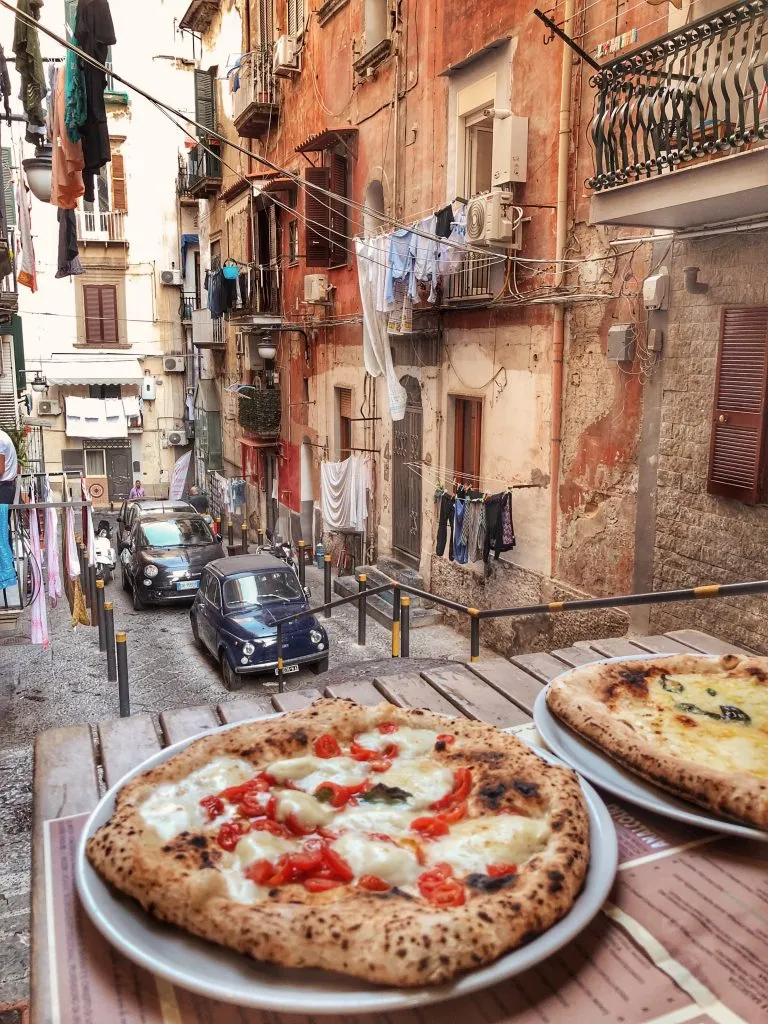

Feel free to order an entire pizza for yourself.
Italian pizzas come in one size only—you won’t find small, medium, or large options on the menu—and they are intended to be enjoyed by one person!
This means there’s no need to negotiate toppings with your friends; everyone can choose the pizza they desire.
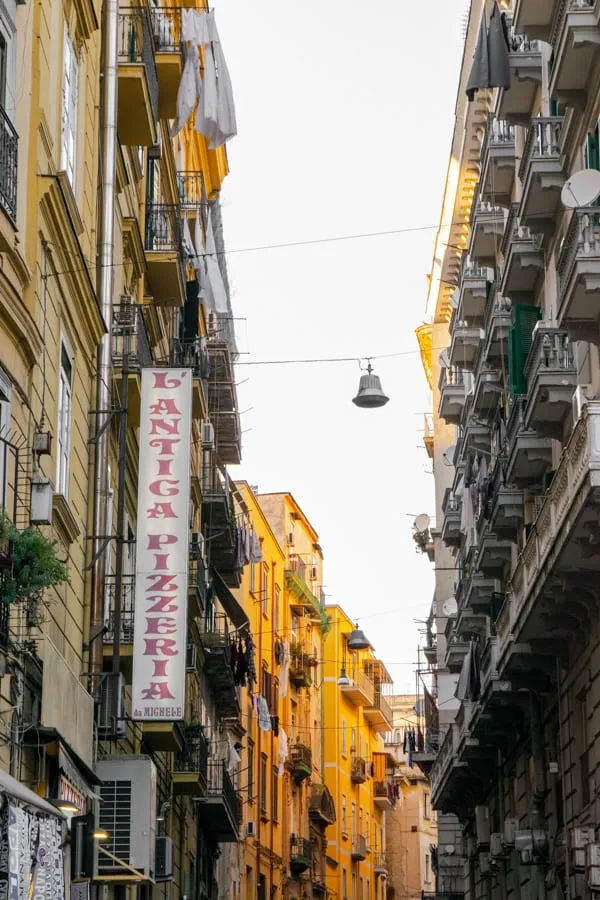

Your pizza will not be sliced.
Prepare to roll up your sleeves! In Italy, your pizza arrives as a whole, round pie.
You’ll typically cut it using a standard knife and fork, but sometimes…
… you may find a pair of scissors for slicing your pizza.
Indeed, scissors!
We’ve encountered this a few times during our countless pizza experiences in Italy, and it does happen.
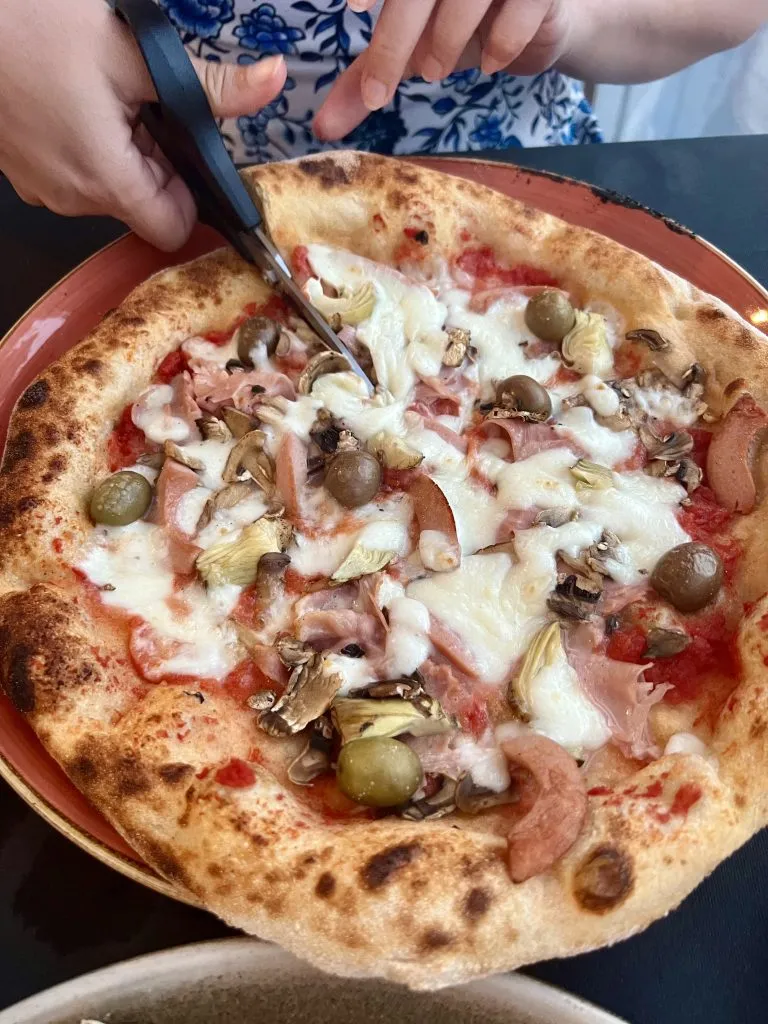

While Italy is famous for its wine, choose beer with your pizza.
Although Italy offers many traditional cuisines best enjoyed with a glass of local wine, pizza isn’t one of them!
In Italy, it’s customary to sip a cold beer alongside your pizza instead.
A classic choice is the standard Italian Peroni, but for something inexpensive and frequently local, order a birra alla spina (draft beer).


Do not overlook pizza bianca!
Not a fan of tomato sauce?
No problem—pizza bianca has got you covered.
While it’s less traditional than pizza rossa (red pizza), nearly every pizzeria in Italy offers some iteration of “white pizza,” usually made with cream or pesto instead of tomato sauce (or, in some Roman variations, with no base at all).
You might even find pizza carbonara on the menu, inspired by the beloved Roman pasta!


Opt for a pizzeria with a wood-fired oven.
While the best Pizza Napoletana is typically found (where else?) in Naples, pizzaioli (pizza chefs) across Italy create delightful, Naples-inspired pizzas.
One key piece of essential equipment they need, aside from fresh local ingredients, is a wood-burning pizza oven.
If you confirm that a pizzeria uses one, you’re likely to have a great experience!
(Interestingly, this is one reason why Venice often lacks good pizza—wood-fired ovens are prohibited there, so only a handful of pizzerias with grandfathered ovens can access this key tool).


Don’t expect to customize your pizza toppings from a list.
In Italy, pizzas are crafted by the restaurant (or, in many cases, come in a selection of highly traditional Italian styles) rather than being tailored by the customer.
There is no option to “choose 1/2/3 toppings” from a list; what you see is what you get!
… nor will you choose your crust style.
Just like how the size of your Italian coffee is determined by the drink you order instead of selecting a size, the crust of your Italian pizza is determined by the style of pizza the pizzeria specializes in.
Typically, this will be a variation of the Neapolitan crust—it’s thin yet chewy, with raised edges—but you’ll encounter various styles throughout Italy as well (more on that later).


Pizzerias often have longer hours (perfect for early or late meals).
While Italian restaurants are known for limited dining hours, commonly from 7:00 PM to roughly 10:30 PM for dinner, pizzerias often stay open longer, starting earlier and closing later.
If your schedule doesn’t align with traditional Italian meal times, pizza can be an excellent option!


Keep your translation app ready when ordering pizza in Italy.
While some pizzerias—especially in tourist areas—will provide English translations on their menus, many do not!
And while your Italian culinary vocabulary may improve as you go, memorizing the names of every possible pizza topping can be overwhelming.
Translation apps can be a great help (we usually rely on Google Translate).
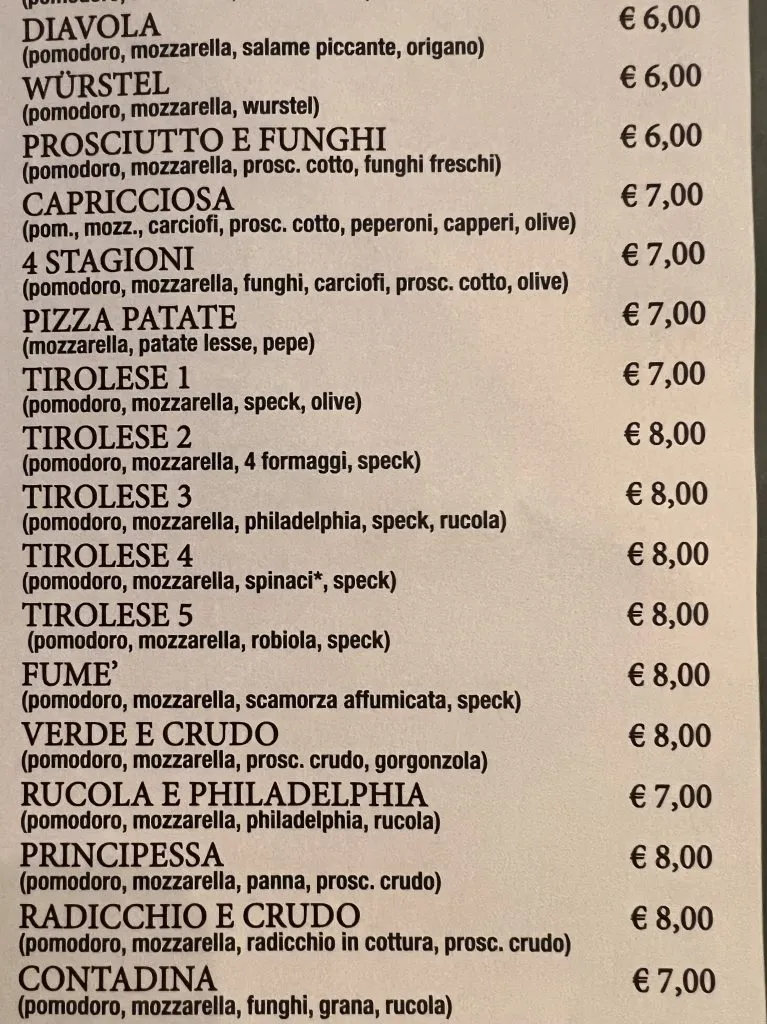

If you want to eat pizza like a (fancy) Italian, grab your knife and fork.
Traditionally, pizza served in Italian pizzerias is eaten with a knife and fork, rather than by hand.
Sliced pizza, sold as street food, is typically consumed directly by hand.
However, this can vary quite a bit (unless you’re dining at an upscale establishment).
You’ll definitely need a knife and fork (or scissors) to begin with, as pizzas in Italy are served whole!
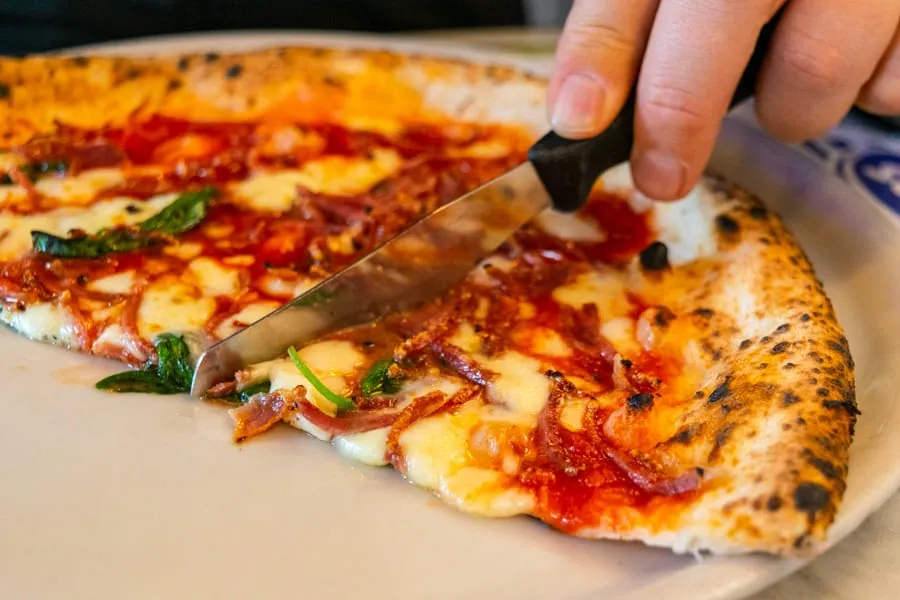

Pizza in Italy is incredibly affordable, so you aren’t misreading the menu!
Prices can vary dramatically depending on the region, but wherever you are, expect the cost of a pizza served in a sit-down restaurant to be about the same or even slightly less than a basic pasta dish.
In southern Italy, you can find pizza for well under 10 Euro, and a Margherita pizza from the famous L’Antica Pizzeria da Michele in Naples only costs a flat 5 Euro!
(However, I can’t resist noting that this is a full Euro higher than the 4 Euro we paid on our first visit back in 2018—things do change!).


Different Styles of Pizza in Italy
While you won’t find options like thin crust, homestyle crust, or pan crust when enjoying pizza in Italy—let alone anything resembling Chicago deep dish—there are various styles you may encounter!
Here’s a brief overview of what to look for:
Pizza Napoletana
Pizza Napoletana, or Neapolitan pizza, is the most iconic Italian pizza style, originating in Naples and imitated (with varying success) across Italy and worldwide.
Simple ingredients are allowed to shine, and the hallmark is a thin, chewy crust with raised edges that cooks in around 90 seconds.
Most of this guide focuses on Neapolitan-style pizza, which is the most commonly found variety.


Pizza al Taglio
Pizza al Taglio, or “pizza by the cut,” is baked in a large rectangular tray and served casually as takeaway or street food.
This style originates from Rome but has spread to various locations throughout Italy!
Pizza al Taglio is generally sold by weight and makes for a perfect quick snack between sightseeing stops or a convenient option to take back to your hotel.
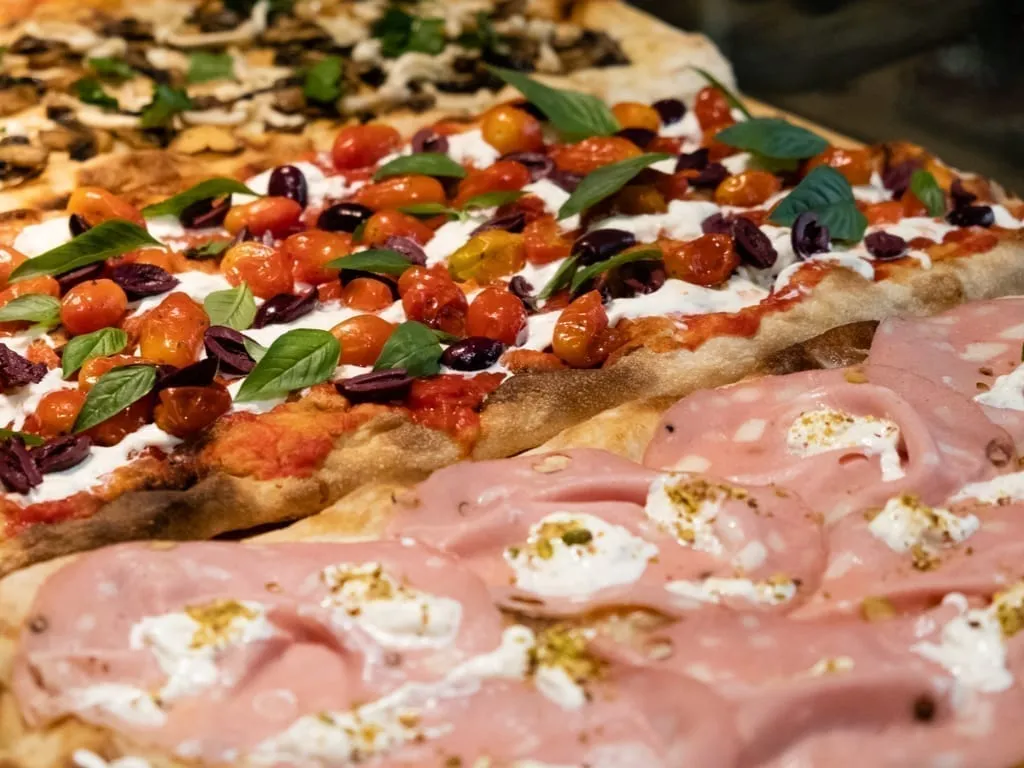

Sfincione
Sfincione, or Sicilian-style pizza, originated in Palermo and has become a popular street food!
This pizza features a thick crust and is typically topped with tomato sauce, pecorino cheese, olive oil, onions, and often anchovies.
It bears little resemblance to the “Sicilian pizza” that you might see in American pizzerias, though if you squint, you may detect a slight inspiration (the thick crust, to be specific).
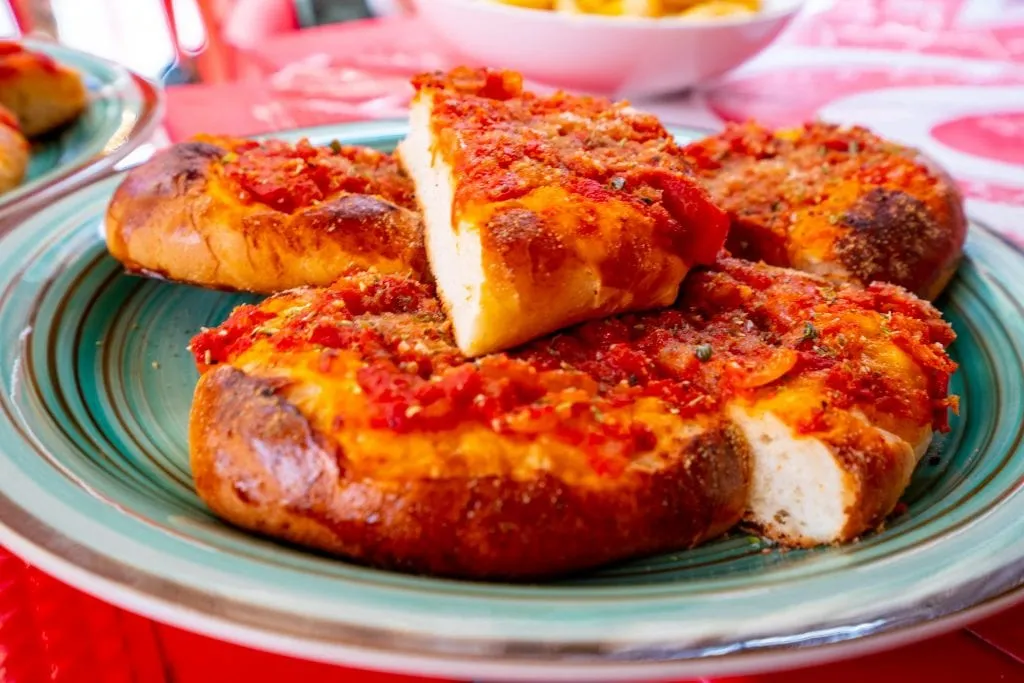

Pizza alla Romana
Originating in Rome but now found in various places, Pizza alla Romana is also a round pizza served on a round plate.
However, unlike Neapolitan pizza, Roman pizza has a thin crust throughout (with no raised edges for toppings), providing a crispier base, thanks to the oil incorporated into the dough.
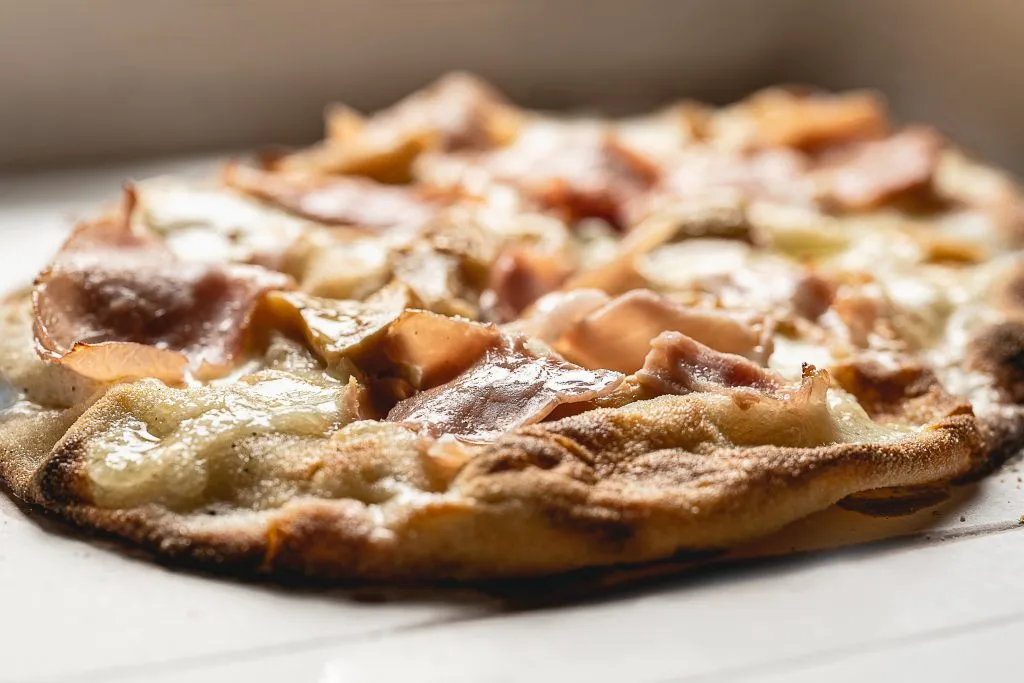

Pizza al Padellino
Translated as “pan pizza” (though not quite like the kind found in the US), Pizza al Padellino is baked in small, round pans.
It’s the closest a traditional pizza in Italy comes to a deep-dish pizza!
However, since it originates from Turin, most first-time visitors to Italy may not encounter it.
(For the record, the Piedmont region is incredible and absolutely worth a visit for food, wine, history, and nature lovers!).
Pizza alla Pala
This pizza, known as “paddle pizza,” is traditionally served on a wooden paddle and is typically baked in an electric oven.
The dough used is “stretched,” giving it a higher rise and providing a chance to enjoy a less common pizza option in Italy.


Pizza Fritta
Fried pizza, often referred to as the “other” pizza from Naples, is made from fried dough and topped with ingredients.
Legend has it, this delicacy emerged from food and equipment shortages after WWII and has periodically surged in popularity.
It’s a delicious alternative that offers a unique pizza experience in Italy!
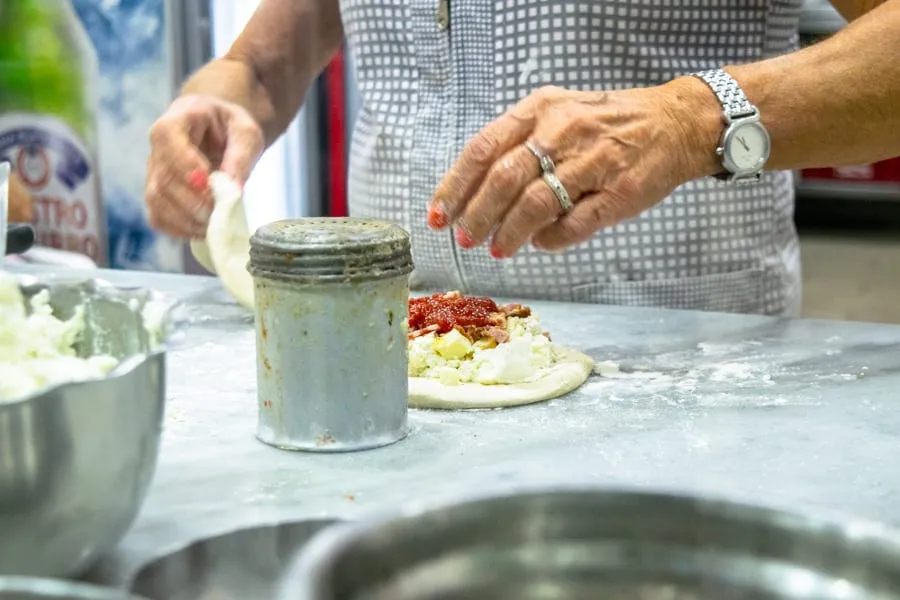

10 Common Types of Pizza to Order in Italy
While many pizzerias in Italy also offer unique creations alongside classic options, you’ll generally find specific Italian pizzas on most, if not all, pizza menus in Italy.
This list certainly isn’t exhaustive, but it should give you a sense of classic pizzas you’ll see repeatedly (though be aware that you may encounter regional or simply restaurant-specific variations).
Here are some of the most common pizzas you can order in Italy!


Margherita
If you try just one classic pizza in Italy, make it this one: the Pizza Margherita is a true icon in Naples and throughout Italy!
This pizza is traditionally prepared with San Marzano tomatoes, mozzarella di bufala, basil, and olive oil—simple yet perfect, they even resemble the colors of the Italian flag.
The Margherita pizza is the most traditional pizza in Italy, likely the most consumed as well!
If you’re outside of Naples, the tomatoes used may vary, and the mozzarella might not be bufala (or you might have the option to upgrade for an extra Euro), but a Margherita pizza will almost certainly be on the menu at any Italian pizzeria.
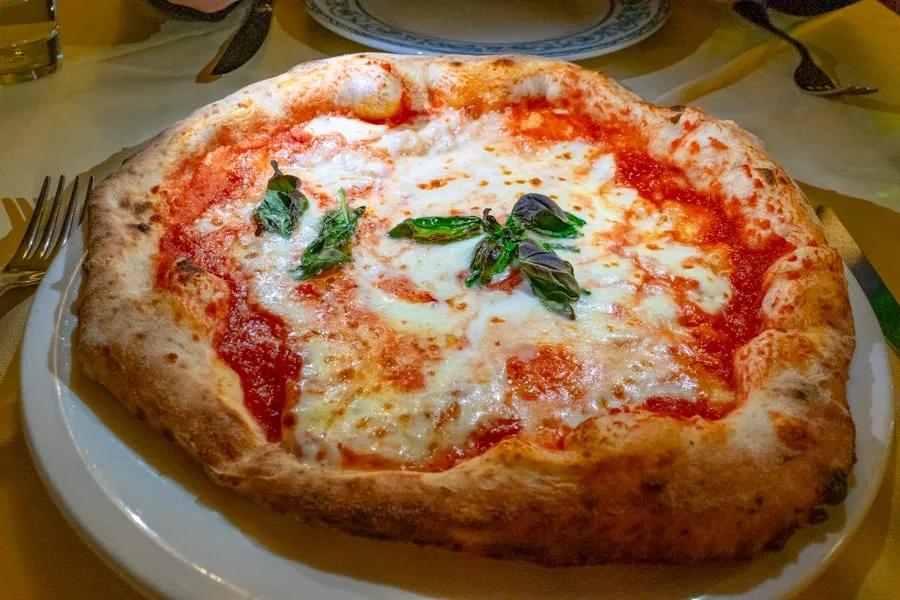

Marinara
The simplest traditional Italian pizza, the Pizza Marinara, lacks even cheese!
This pizza features tomato sauce, oregano, olive oil, and garlic, allowing the crust and tomato sauce to be the stars of the show.
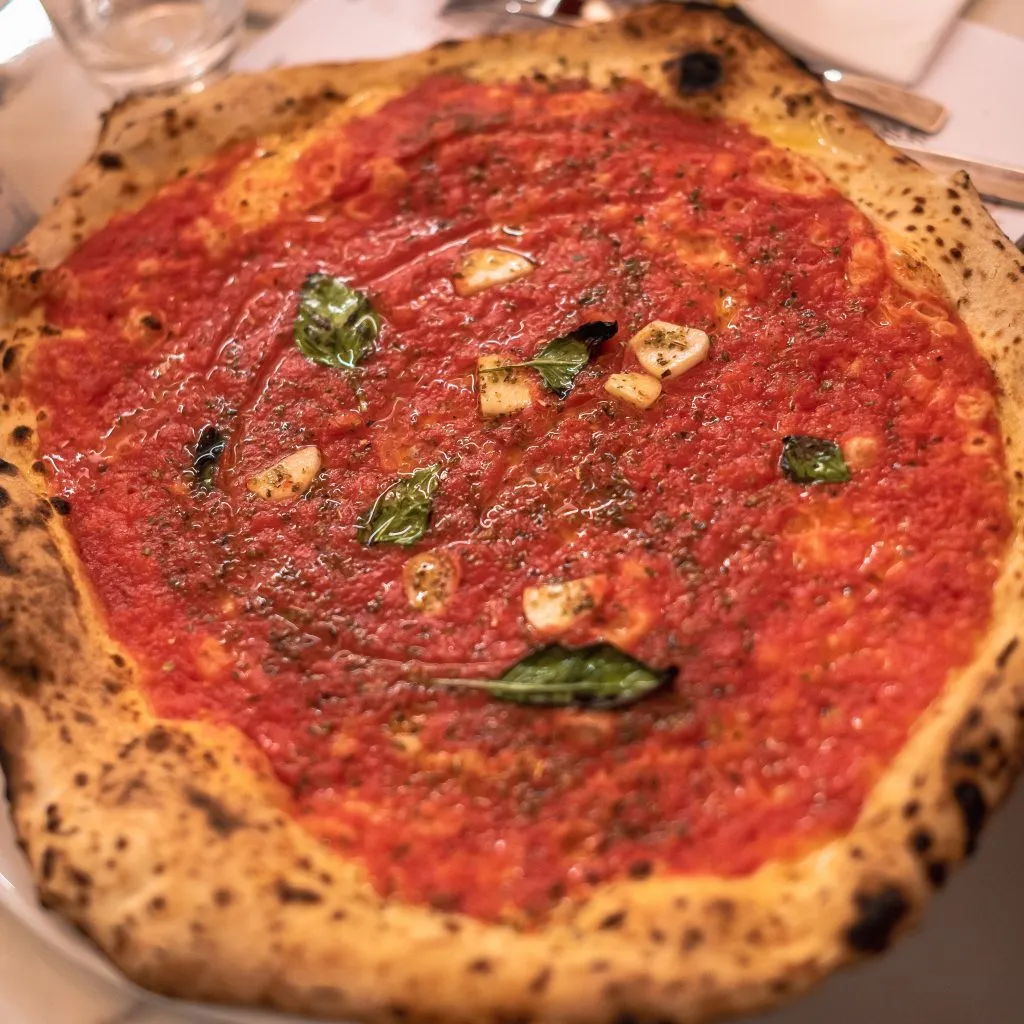

Diavola
If you’re a fan of pepperoni pizza back home, a Diavola will be the nearest equivalent you’ll find on Italian menus!
This pizza is topped with mozzarella cheese, tomato sauce, spicy salami, and often includes hot peppers or chilis for an extra zing.
Some variations may even feature black olives.
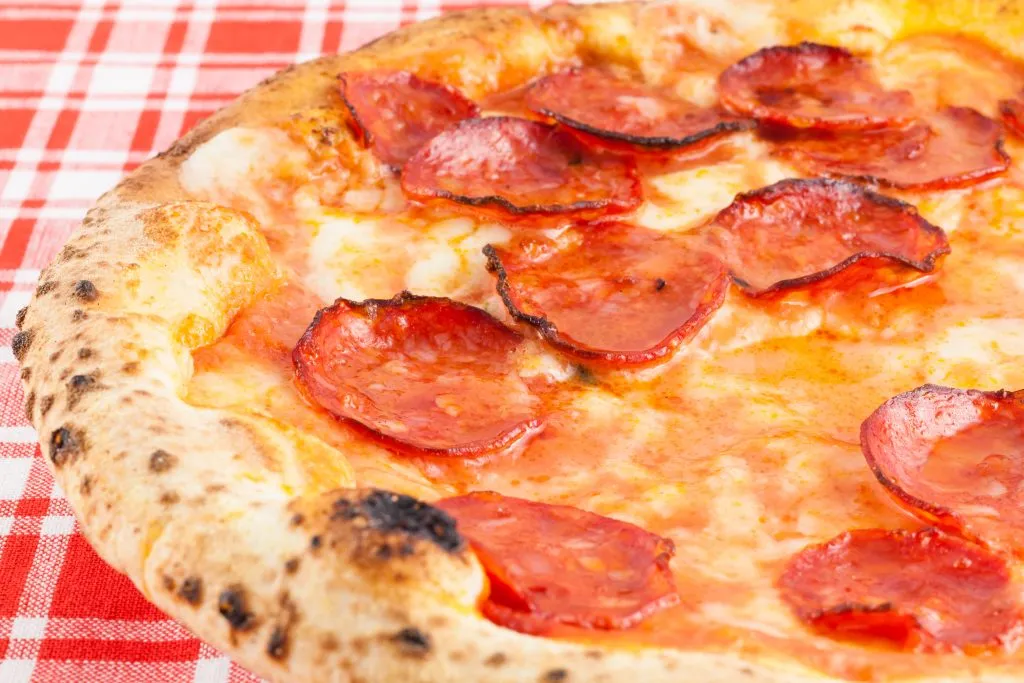

Quattro Formaggi
Quattro Formaggi translates literally to “four cheeses,” and that’s exactly what you’ll find when you order this traditional pizza in Italy!
Originating from Campania (like many Italian pizza traditions), the most commonly used cheeses are mozzarella, gorgonzola, fontina, and parmigiano-reggiano.
However, apart from mozzarella and gorgonzola, the other cheeses can vary based on the pizzeria and region!
Sometimes this pizza is served with tomato sauce; other times, it is presented as a pizza bianca.
If you’re dining with a child (or adult!) looking for a familiar “cheese pizza,” a Quattro Formaggi can be more comforting than a Margherita.
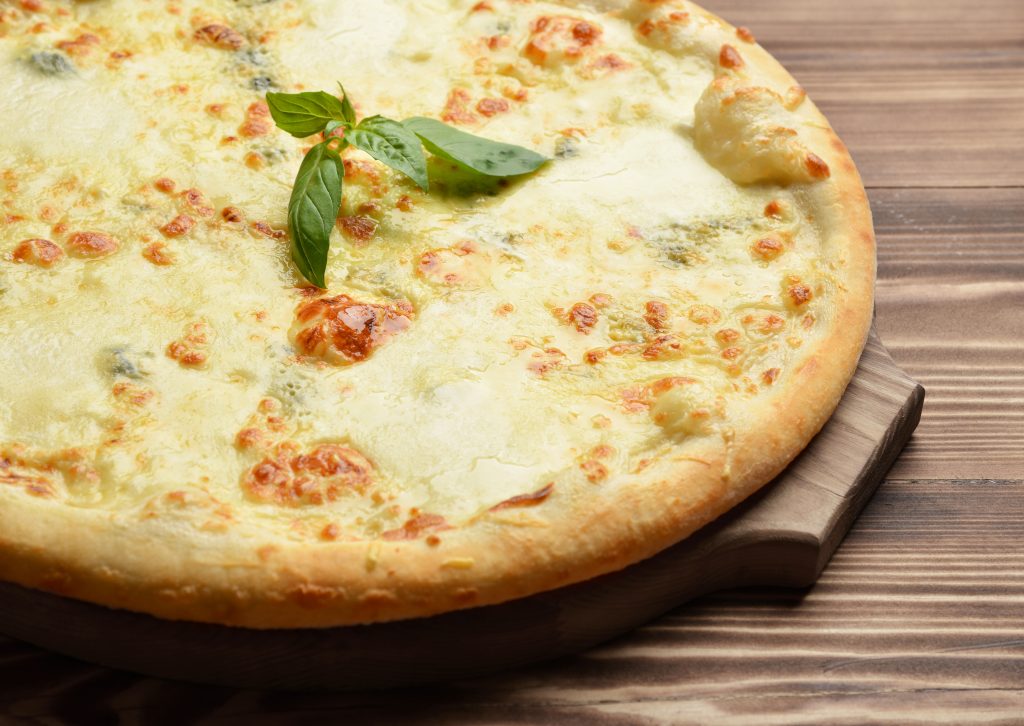

Quattro Staggioni
Ideal for travelers wanting to try a little bit of everything, the Quattro Stagioni (or “four seasons”) pizza features tomato sauce and mozzarella, topped with olives, ham, mushrooms, and artichokes.
Each of the four toppings occupies its own quadrant of the pizza, making it feel like you’re ordering four pizzas in one!
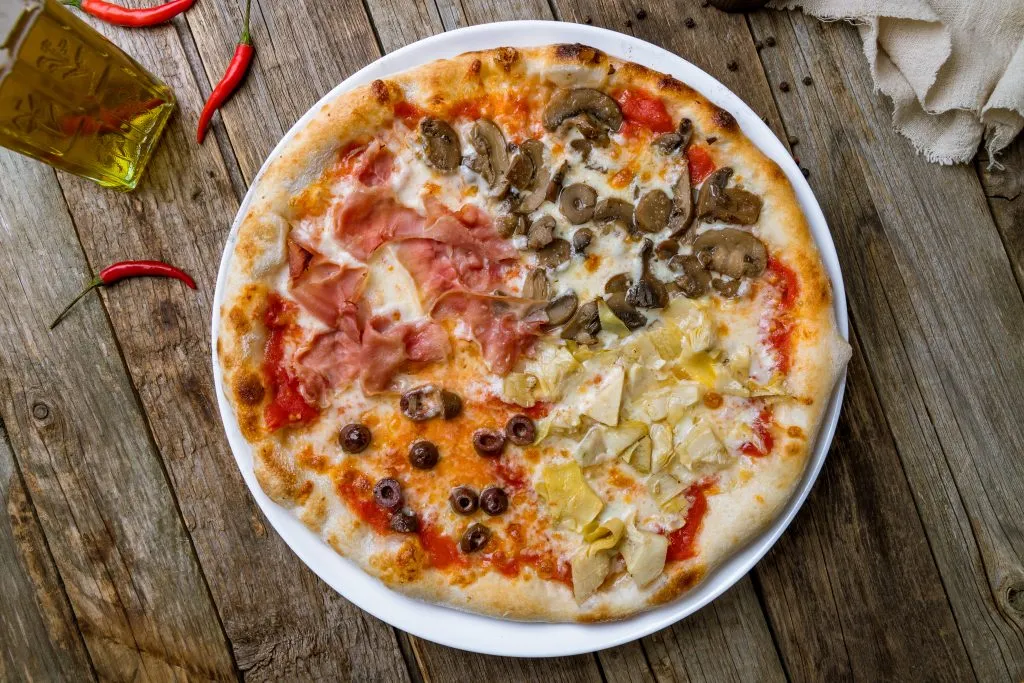

Capricciosa
This is one of my personal favorites (I often treat myself to this pizza multiple times on each trip to Italy). The Capricciosa is essentially a “mixed-up” version of the Quattro Staggioni.
This means you can expect tomato sauce and mozzarella topped with ham, mushrooms, artichokes, and olives—though these toppings are mixed evenly across the pizza.
Regional variations exist, with some pizzerias including peppers and/or salami, or omitting olives altogether; however, the traditional version aligns with the one provided above.


Prosciutto e Funghi
This simple and delicious pizza features tomato sauce, mozzarella, prosciutto cotto, and mushrooms.
While it may be straightforward, it remains a beloved staple on Italian pizza menus!
Prosciutto e Rucola
For travelers from the US, having cold ingredients atop a pizza may come as a surprise—yet fresh arugula is a popular topping in Italy!
The Proscuitto e Rucola combines the saltiness of the prosciutto with the crispness of arugula for a delightful combination.
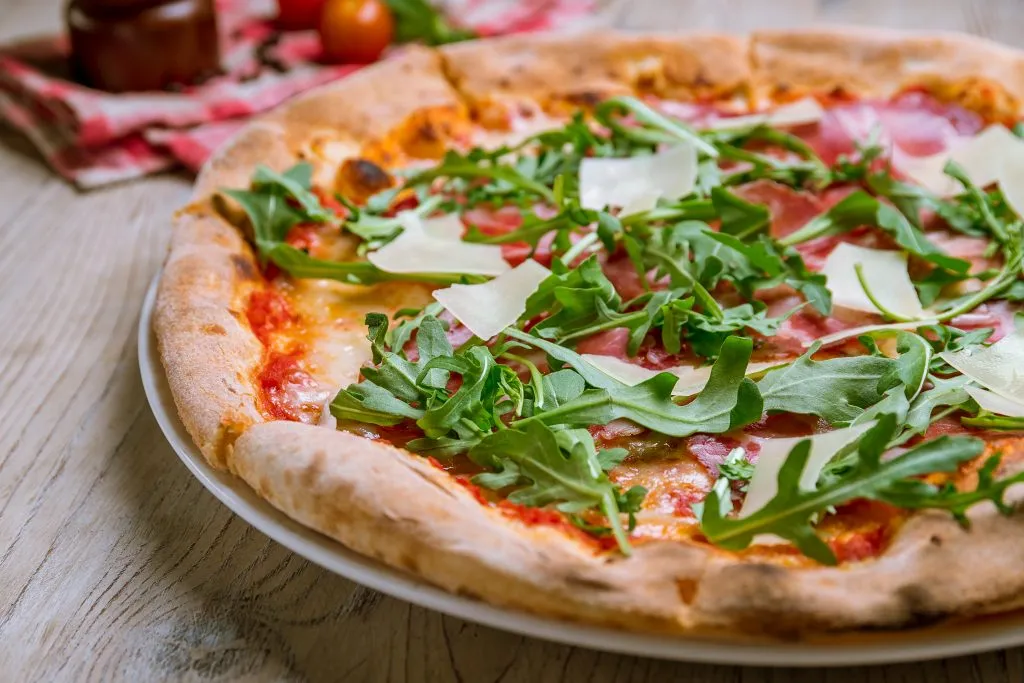

Ortolana
This veggie-topped pizza, known as Ortolana, is traditionally made with eggplant, zucchini, artichoke hearts, and bell peppers, along with tomato sauce and mozzarella.
The name Ortolana translates to “greengrocer’s pizza,” reflecting its origin!
Like the Capricciosa or Diavola, you may find numerous local variations of which vegetables are included, so make sure to review the menu if certain veggies are not to your liking.
Frutti di Mare
Literally meaning “seafood pizza”, Frutti di Mare is typically topped with shrimp, mussels, or squid.
If you’re a seafood lover visiting one of Italy’s many beach towns, this is a must-try!
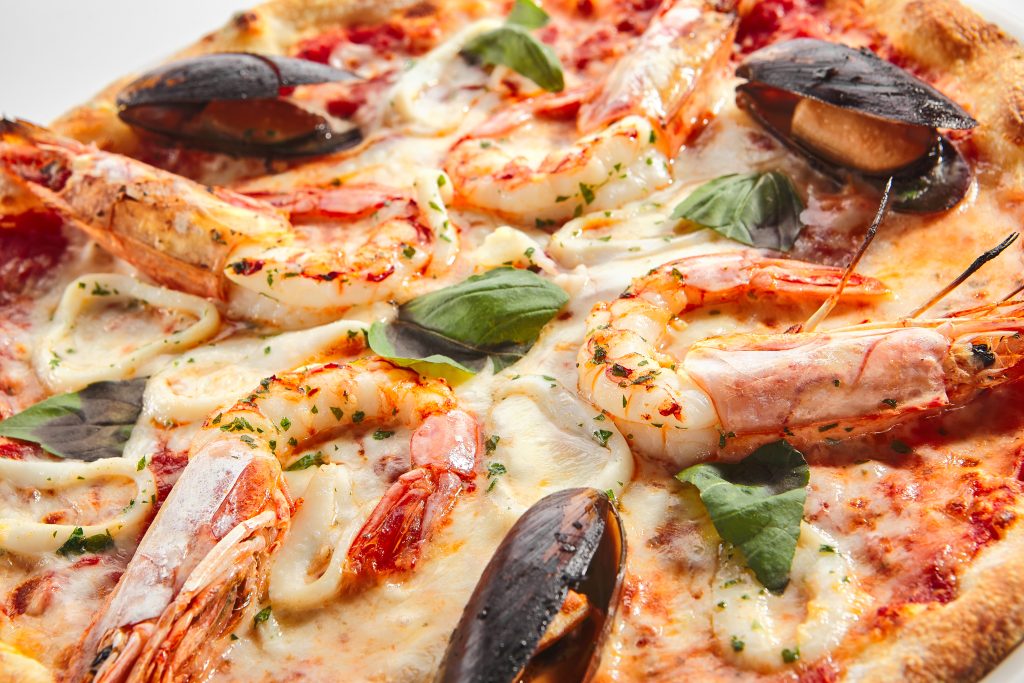

Read More About Food Culture in Italy





